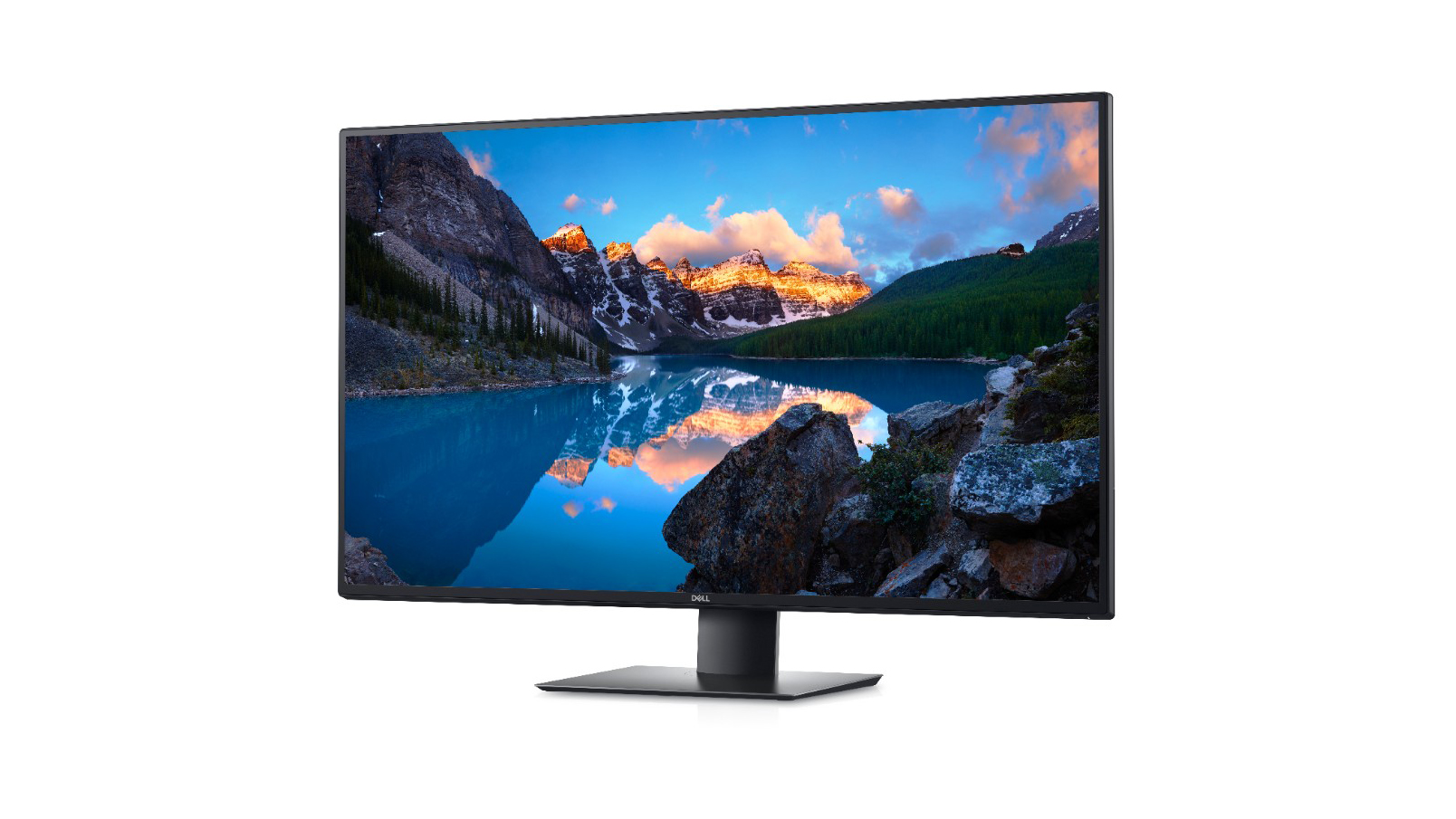Dell UltraSharp U4320Q review: Prepare to be impressed
A monster monitor that packs a surprising amount of image quality for the size and the price

-
+
Surprisingly good image quality
-
+
Capable speakers
-
+
Smart OSD
-
-
Truly mammoth size
-
-
Limited adjustability
-
-
Imperfect contrast

It amuses our childish sense of humour that, on the Dell homepage for this monitor, a lady sits gazing at the monitor on the desk before her with what appears to be an astonished facial expression. As well she might: the U4320Q is a simply enormous monitor that takes some getting used to, even if you’re upgrading from a 34in display.
But who needs a desktop monitor this big? Well, for one thing, Dell has financial applications in its sights; this monitor includes picture-by-picture support, with the option of displaying the input from up to four different computers simultaneously. This is admittedly a niche use-case, but larger screens are useful for a host of other roles, including graphic designers who need to edit images, or those working with high-density spreadsheets. They’re also helpful for those who are visually impaired and need everything to be BIG. It helps that this panel has a 4K resolution that delivers 103ppi density - that’s sharp at typical desk viewing distances.
You are, however, hitting the limits of usability. Shifting your gaze from the left to the right of the panel is reminiscent of spectators transfixed by a rally on Wimbledon’s Centre Court, and if you don’t move an app’s window into a more central location then you can end up with a crick in your neck. The fact this isn’t a curved screen also counts against it; the fact that it doesn’t reflect the curvature of your eye creates an optical illusion of the screen almost bending away from you.
While it isn’t the very best screen around when it comes to image quality, Dell has chosen a surprisingly capable IPS panel for its size. It’s tuned for the sRGB colour space - as you would expect for a “professional” monitor - and covers an excellent 96.5% of the sRGB colour space. That’s right in line with Dell’s claims.
There’s no support for hardware calibration, nor does Dell make any promises about Delta E, but we measured an excellent average of 0.88. It could only cover 69.5% of the Adobe RGB space, and 72.5% of DCI-P3, but such a low Delta E means that if you stick to sRGB then you’re buying a colour accurate monitor. Its one area of weakness was contrast, which dropped to 889:1 when we shifted to the 6500K colour temperature (this was where it produced the most accurate colours). It’s even a capable gaming monitor thanks to a 5ms response time, but there’s no support for adaptive sync and it will only refresh at its peak 75Hz if you drop down to 1,280 x 1,024.
The last thing to note about image quality is that this panel is a slave to its size: while you can expect fine colour accuracy towards the centre of the panel, it’s telling that measured brightness dropped off by as much as 10% at the edges. It also starts to reach the limits of IPS panel technology when it comes to viewing angles, with a discernible drop-off in contrast when you look at this display’s extremes.
Dell’s OSD provides a sprinkling of options when it comes to colour presets, including a selection of colour temperatures. You can also select the sepia-tinted ComfortView and Standard, or create your own custom setting by fiddling with the controls. It’s one of the more intuitive on-screen displays, but a little odd that Dell wastes one of the four buttons as a shortcut for volume rather than brightness.
Perhaps it wanted to emphasise how powerful the pair of 8W speakers packed inside the casing are, because if volume is your main objective then they have no equal here. They’re pleasant for listening to music on, too, with enough bass to rival a typical set of Bluetooth speakers. Good thing too, as you’re unlikely to have much desktop space next to this thing.
You can also sweep away wires thanks to a USB-C input that delivers up to 90W of power to connected laptops, and while there’s no RJ-45 connector or KVM switch there are three USB-A ports. One of these sits conveniently to the left of the monitor, alongside a downstream USB-C port that can provide power up to 15W, but the remaining two USB-A ports snuggle next to the DisplayPort input and twin HDMI ports at the rear.
Getting to these is a real hassle even with the stand’s 60mm of height adjustment. Bearing in mind its size and 17.6kg weight, you’ll want to try and get as many of your cables organised right from the start. Helpfully, there’s a neat cable tidy built into the stand. Once settled, there isn’t much flexibility, with a minimal amount of tilt and a total swivel of 40°. Still, considering the size of this panel, it’s quite impressive that Dell offers any such movement.
In fact, “impressive” is an apt word for this screen in general. Its sheer size impresses; its image quality, with caveats, impresses; and it’s even impressive that Dell keeps the price to under £1,000. You really do need a strong reason to choose such a large monitor, but if you do then, well, prepare to be impressed.
Dell UltraSharp U4320Q specifications
| Screen size | 42.5in |
| Screen resolution | 3,840 x 2,160 |
| Screen technology | IPS |
| Screen refresh rate | 75Hz |
| Video inputs | 1x DisplayPort 1.4, 2x HDMI, 1x USB Type-C |
| Audio inputs/outputs | N/A |
| Speakers | 2x 8W |
| Ports | 3x USB 3, USB-B, 1x USB Type-C (90W) |
| Adjustability | 60mm height adjustment, -5°/+10° tilt, 40° swivel |
| Dimensions | 967 x 249 x 595-655mm |
| Weight | 17.6kg |
| Warranty | 3yr |
Get the ITPro daily newsletter
Sign up today and you will receive a free copy of our Future Focus 2025 report - the leading guidance on AI, cybersecurity and other IT challenges as per 700+ senior executives
Tim Danton is editor-in-chief of PC Pro, the UK's biggest selling IT monthly magazine. He specialises in reviews of laptops, desktop PCs and monitors, and is also author of a book called The Computers That Made Britain.
You can contact Tim directly at editor@pcpro.co.uk.
-
 Westcon-Comstor and Vectra AI launch brace of new channel initiatives
Westcon-Comstor and Vectra AI launch brace of new channel initiativesNews Westcon-Comstor and Vectra AI have announced the launch of two new channel growth initiatives focused on the managed security service provider (MSSP) space and AWS Marketplace.
By Daniel Todd Published
-
 Third time lucky? Microsoft finally begins roll-out of controversial Recall feature
Third time lucky? Microsoft finally begins roll-out of controversial Recall featureNews The Windows Recall feature has been plagued by setbacks and backlash from security professionals
By Emma Woollacott Published
-
 The UK government wants quantum technology out of the lab and in the hands of enterprises
The UK government wants quantum technology out of the lab and in the hands of enterprisesNews The UK government has unveiled plans to invest £121 million in quantum computing projects in an effort to drive real-world applications and adoption rates.
By Emma Woollacott Published